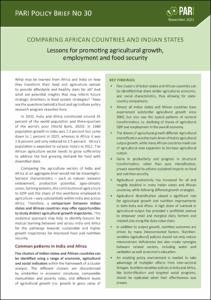Comparing African Countries and Indian StatesLessons for promoting agricultural growth, employment and food security

Comparing African Countries and Indian States
Lessons for promoting agricultural growth, employment and food security

| dc.contributor.author | Baumüller, Heike | |
| dc.contributor.author | Gulati, Ashok | |
| dc.contributor.author | Jose, Shyma | |
| dc.contributor.author | Kornher, Lukas | |
| dc.contributor.author | Usman, Muhammed | |
| dc.contributor.author | von Braun, Joachim | |
| dc.date.accessioned | 2022-06-20T14:59:26Z | |
| dc.date.available | 2022-06-20T14:59:26Z | |
| dc.date.issued | 11.2021 | |
| dc.identifier.uri | https://hdl.handle.net/20.500.11811/9887 | |
| dc.description.abstract | What may be learned from Africa and India on how they transform their food and agriculture sectors to provide affordable and healthy diets for all? And what are potential insights that may inform future strategic directions in food system strategies? These are the questions behind a food and agriculture policy research program reported here.
In 2020, India and Africa constituted around 35 percent of the world population and three-quarters of the world’s poor (World Bank, 2020). In 1980 population growth in India was 2.3 percent but came down to 1 percent in 2020, whereas in Africa it was 2.8 percent and only reduced to 2.5 percent. Africa’s population is expected to surpass India’s in 2022. The African agriculture sector needs to grow sufficiently to address the fast growing demand for food with diversified diets. Comparing the agriculture sectors of India and Africa at an aggregate level would not be meaningful. Sectoral characteristics – such as natural resource endowment, production potential, agro-climatic zones, farming systems, the contribution of agriculture to GDP and the share of the workforce employed in agriculture – vary substantially within India and across Africa. Therefore, a comparison between Indian states and African countries may offer opportunities to study distinct agricultural growth trajectories. This analytical approach may help to identify lessons for mutual learning between and across India and Africa for the pathways towards sustainable and higher growth trajectories for improved food and nutrition security. | en |
| dc.format.extent | 5 | |
| dc.language.iso | eng | |
| dc.relation.ispartofseries | PARI Policy Brief ; 30 | |
| dc.rights | In Copyright | |
| dc.rights.uri | http://rightsstatements.org/vocab/InC/1.0/ | |
| dc.subject | Food and nutrition security | |
| dc.subject | Policy | |
| dc.subject | Crops | |
| dc.subject | Livestock | |
| dc.subject | Africa | |
| dc.subject | India | |
| dc.subject | Agricultural production | |
| dc.subject.ddc | 320 Politik | |
| dc.subject.ddc | 330 Wirtschaft | |
| dc.subject.ddc | 630 Landwirtschaft, Veterinärmedizin | |
| dc.title | Comparing African Countries and Indian States | |
| dc.title.alternative | Lessons for promoting agricultural growth, employment and food security | |
| dc.type | Arbeitspapier | |
| dc.identifier.doi | https://doi.org/10.48565/bonndoc-25 | |
| dc.publisher.name | Center for Development Research (ZEF) | |
| dc.publisher.location | Bonn | |
| dc.rights.accessRights | openAccess | |
| dc.relation.url | https://research4agrinnovation.org/app/uploads/2021/11/pari_policybrief30.pdf | |
| ulbbn.pubtype | Zweitveröffentlichung |
Dateien zu dieser Ressource
Das Dokument erscheint in:
-
PARI Policy Briefs (49)




